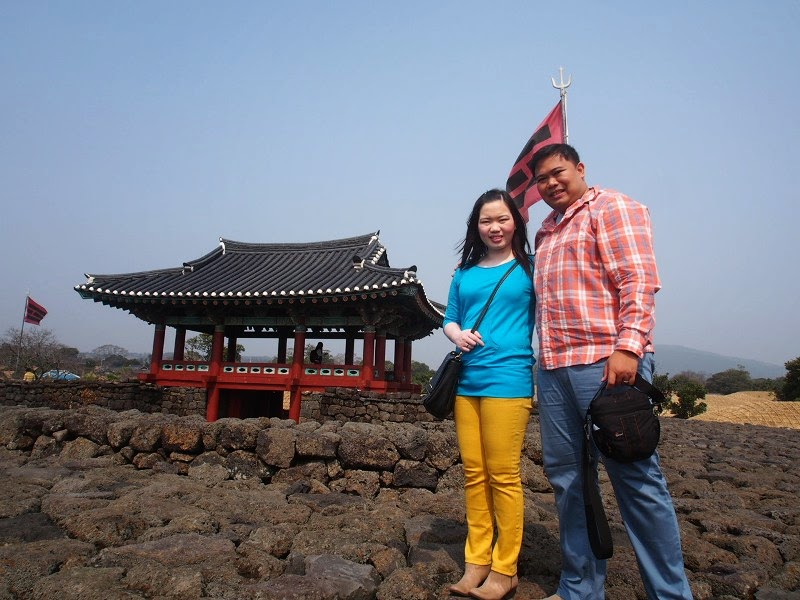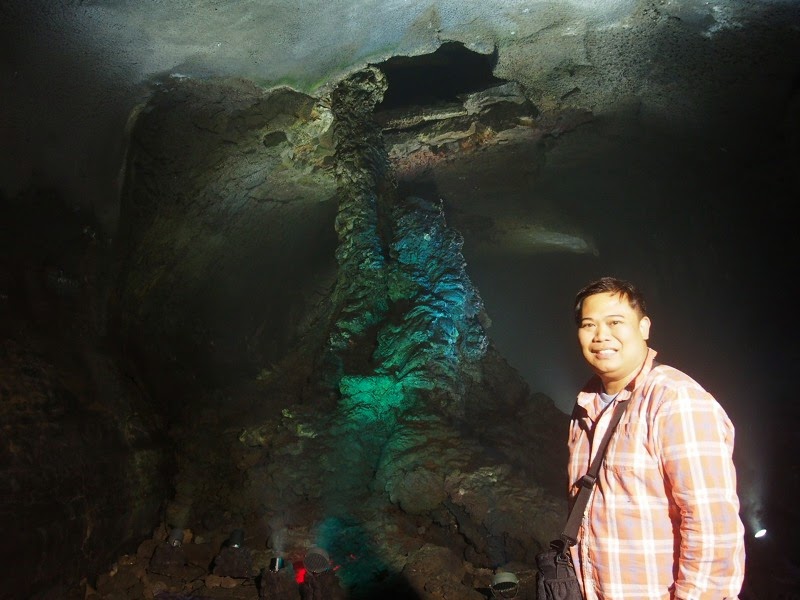Jeju Province is one of the nine provinces of South Korea. The province is situated on and coterminous with the nation's largest island of Jeju, formerly transliterated as Cheju, Cheju Do, etc., or known as Quelpart to Europeans. The island lies in the Korea Strait, southwest of South Jeolla Province, of which it was a part before it became a separate province in 1946. Its capital is Jeju City.
The island was created entirely from volcanic eruptions approximately 2 million years ago, during the time period extending from the Tertiary to the beginning of the Quaternary period, and consists chiefly of basalt and lava. The eruptions took place in the Cenozoic era. It has a humid subtropical climate, warmer than that of the rest of Korea, with four distinct weather seasons. Winters are cool and dry while summers are hot, humid, and sometimes rainy.
Tourism commands a large fraction of Jeju's economy. Jeju's temperate climate, natural scenery, and beaches make it a popular tourist destination for South Koreans as well as visitors from other parts of East Asia. The most popular tourist spots on the island are Cheonjeyeon and Cheonjiyeon waterfalls, Mount Halla, Hyeobje cave, and Hyeongje island. Depending on the season, Jeju hosts many festivals for tourists including a penguin swimming contest in winter, cherry blossom festival in spring, the midsummer night beach festival in summer, and Jeju horse festival in autumn, among others. Some local products are popular with tourists, including Jeju's special tile fish and mandarin oranges, as well as souvenirs and duty-free shopping.
Jeju was chosen as one of the New 7 Wonders of Nature through the New 7 Wonders of Nature campaign by the New7Wonders Foundation. The campaign saw hundreds of millions of votes and the top seven wonders were announced on 11/11/11.
Please check our 6-day Seoul and Jeju Island, South Korea Itinerary...
Please check our 6-day Seoul and Jeju Island, South Korea Itinerary...
For our Jeju trip, we took the East Course bus tour of Yeha Tour. You may want to check their website for online booking and their package tour details (www.yehatour.com):
Top Tourist Spots and Sites to Visit:
1.) Seongsan Ilchulbong
Seongsan Ilchulbong, also called ‘Sunrise Peak’, is an archetypal tuff cone formed by hydrovolcanic eruptions upon a shallow seabed about 5 thousand years ago. Situated on the eastern seaboard of Jeju Island and said to resemble a gigantic ancient castle, this tuff cone is 182 meters high, has a preserved bowl-like crater and also displays diverse inner structures resulting from the sea cliff. These features are considered to be of geologic worth, providing information on eruptive and depositional processes of hydromagmatic volcanoes worldwide as well as past volcanic activity of Seongsan Ilchulbong itself.
Most volcanic cones or oreums (Jeju dialect for volcanic cones) were formed by piles of scoria cones which are created by Hawaiian eruptions or Strombolian eruptions. But Seongsan Ilchulbong Tuff Cone and a few other oreums on Jeju Island were hydromagmatic volcanoes which were made by piles of volcanic ash, the interaction of hot ascending magma and seawater or ground water. Seongsan Ilchulbong Tuff Cone is 180 meters high, and its crater is about 600 meters in diameter.
There are numerous hydromagmatic volcanoes similar to the Seongsan Ilchulbong, but there are no other known hydromagmatic volcanoes with a well-preserved tuff cone and diverse internal structures along a sea cliff. Because of these scientific values and remarkable scenery, Seongsan Ilchulbong Tuff Cone was able to be designated as a UNESCO World Natural Heritage site and it is worth preserving permanently as a natural heritage of humankind.
Located at the foot of Mt. Halla on Jeju Island, Seongeup Folk Village is a small town that holds a vast amount of culture.
Cultural properties in the folk village have been handed down from generation to generation and include treasures such as residential houses, Confucian shrines and schools, ancient government offices, stone statues, large millstones (pulled by horses or ox), fortress ruins, and stone monuments. Among the cultural gems of the folk village are intangible cultural assets such as folk plays, native foods, local folk craftsmanship, and local dialect. Even the trees are an important part of the area’s heritage. Several zelkova and nettle trees that are hundreds of years old stand at the center of the village, preserving the dignified atmosphere of a bygone era.
The Seongeup Folk Village shows the unique culture of Jeju Island: the black lava rock walls, the straight but curvy alleys to block the wind, and the stone grandfather statues (Harubang), which have become a prime feature of the landscape. The local black-haired pigs and tongsi (pigsty / restroom) are especially well-known characteristics of Jeju folk culture. The Jeju black pork is said to be very nutritious.
Seongeup Folk village served as one of the filming locations for the multi-awarded and well known TV miniseries Daejanggeum, in English, “the Great Jang-geum,” also known as the Jewel in the Palace.
3.) Haenyo
The haenyo, literally meaning "sea women", are female divers in the Korean province of Jeju. They are representative of the matriarchal family structure of Jeju.
The haenyo, literally meaning "sea women", are female divers in the Korean province of Jeju. They are representative of the matriarchal family structure of Jeju.
From the late 1970s, exports of sea products to Japan such as abalone and conch have made the sea women richer than ever, allowing them to fix their houses, build new ones in Jeju City and send their daughters to college. However, there is a threat to the haenyo's continued success: with their daughters choosing to work in the island's tourism industry or in the big cities, the haenyo will most likely disappear. While in 1950 there were as many as 30,000 haenyo on the island, in 2003 there were only 5,650 sea women registered as divers, of whom 85% were over 50 years old. In the early 1960s, 21% of women on the island were free divers, providing 60% of the island's fisheries revenue. With the number of sea women declining and with tourism giving Jeju men more opportunities, it is unclear what will happen to their daughters' status in their communities and home, though it is unlikely that the matriarchal family structures will continue to survive. As of 2014 only about 4,500 haenyeo, most aged over 60, were still actively working. In 2014, South Korea applied to UNESCO to add the haenyo to its Intangible Cultural Heritage List.
The haenyo begin shallow water diving as early as age eleven and move on to deepwater diving by age eighteen. They have been observed diving as long as 65 years of age.
Time in the water varies by season, from as little as 20 minutes during the winter to as long as 95 minutes in the summer. Dives have been observed to last approximately one minute, with 30 seconds spent on the surface between dives. Routine diving occurs in shallow water, but deeper excursions, to 15 or even 20 meters, have been observed. The divers must also contend with other dangers such as jellyfish, and sharks.
4.) Manjanggul Lava Tube





Until next time...Jeju Island...




The Manjanggul Lava Tube is located in Gimnyeong-ri, Gujwaeup, Jeju City and is 23 m in breadth and 30 m in height. As the lava tube stretches for as far as an approximate 7,400 m, its length ranks amongst the top 15 in the world. It is also the largest lava tube in Jeju island. It is regarded as having significant scientific and heritage value, owing to its excellent condition of preservation despite its age of formation (about 300,000 to 200,000 years ago).
Lava stalactites and lava stalagmites, lava columns, lava flowstone, lava helictites, lava blisters, cave coral, benches, lava rafts, lava bridges, lava shelves, grooved lava striations, and ropy lava are well-preserved. Among them, a lava column of 7.6m the largest known in the world. There are three entrances and No. 2 heading southward is open to the public.
Entrance No. 3 contains the most favorable habitats for cave life and between Entrances 1 and 2, there is a lower level main tube where most of the living creatures can be found. In the Geomunoreum Lava Tube System, the Manjanggul Lava Tube has the greatest number of living creatures, including the Jeju cave-spider. In the upper part of Entrance 2, there are at least 30,000 common bent-wing bats forming the largest colony of bats confirmed to be living in Korea so far.
5.) The Trick Art Museum
The Trick Art Museum is the first museum in Korea to show optical illusion art, and is located in Seogwipo City nearby the Seongeup Folk Village. Exhibitions on walls and floors are rendered in three dimensions. Exhibitions consist of seven themed sections: Parody Zone (showing famous paintings and sculptures), Animal Zone, Jurassic Zone, Aquarium Zone, Egypt Zone, Magic Zone, and Illusion Zone.
Trick art renders two dimensional paintings in three dimensions by creating illusion. Each work looks differently when seen from different angles or spots. Its magic magnifies when seen from camera lenses. Visitors can take pictures with various fun poses blending nicely with exhibitions. Cameras as well as video equipment are permitted in the museum.
6.) Jungang Underground Shopping Center
Located in Jungangro of downtown Jeju, Jungang Underground Shopping Center is a modern underground shopping arcade that recently re-opened after a major renovation. Stretching over Jungangro, Seomunro and Dongmunro, the center has over 280 stores selling clothing, shoes, accessories, glasses, watchers, jewelries, bags, hats, flowers, etc. There are also many amenities such as restaurant, fast food chains, as well as rest lounges scattered across the shopping center. It is the only underground shopping arcade in Jeju Island, and offers a pleasant shopping experience.
6.) Jungang Underground Shopping Center
Located in Jungangro of downtown Jeju, Jungang Underground Shopping Center is a modern underground shopping arcade that recently re-opened after a major renovation. Stretching over Jungangro, Seomunro and Dongmunro, the center has over 280 stores selling clothing, shoes, accessories, glasses, watchers, jewelries, bags, hats, flowers, etc. There are also many amenities such as restaurant, fast food chains, as well as rest lounges scattered across the shopping center. It is the only underground shopping arcade in Jeju Island, and offers a pleasant shopping experience.
7.) Tapdong Seaside Concert Hall

Along with Tapdong Square and the breakwater, Tapdong Seaside Concert Hall is one of three famous sites in Tapdong. The three-story building, which sits on 112,000 sqm. of land, resembles Jeju Bangsatop, a stone tower set up to protect villages from bad luck.
It is an open air stage characterized by its enlarged formation of "Bangsatop", a pile of stones traditionally built on Jeju Island. Serving as a cultural space, it offers a wide range of shows every day in summer, drawing citizens out for a delightful musical experience. Inside the building is a coffee shop and an exhibit room.
Until next time...Jeju Island...
























































No comments:
Post a Comment
Note: Only a member of this blog may post a comment.